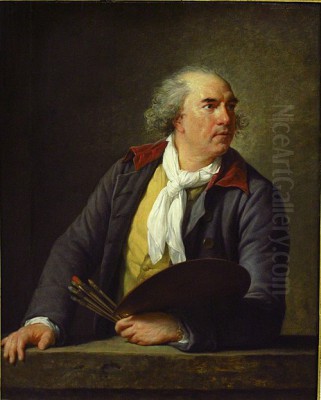
Hubert Robert stands as one of the most captivating figures of eighteenth-century French art. Born in Paris in 1733 and living until 1808, his life spanned a period of immense social, political, and artistic transformation, from the height of the Rococo to the turmoil of the French Revolution and the rise of Napoleon. Primarily celebrated as a painter of landscapes, particularly those featuring architectural ruins, Robert earned the evocative nickname "Robert des ruines" (Robert of the Ruins). Yet, his talents extended beyond the canvas to encompass garden design and decorative arts, making him a versatile and highly sought-after artist of his time. His work uniquely blends topographical observation with imaginative fantasy, creating scenes that are both melancholic and picturesque, reflecting deeply on the passage of time and the dialogue between nature and human creation.
Early Life and Artistic Formation in Paris
Hubert Robert was born into a Paris transitioning from the Regency into the reign of Louis XV. His father, Nicolas Robert, was in the service of François-Joseph de Choiseul, Marquis de Stainville, a prominent diplomat. This connection to the Choiseul family would prove beneficial early in the artist's career. Robert received a solid classical education at the prestigious Collège de Navarre, an experience that likely instilled in him a lifelong appreciation for antiquity, a theme central to his later work.
Initially, Robert's artistic inclinations led him to the studio of the sculptor Michel-Ange Slodtz. There, he studied design and perspective, essential skills for any visual artist. However, his true passion lay not in sculpting marble but in capturing scenes with paint. He soon shifted his focus entirely to painting, setting the stage for a career that would make him one of France's most distinctive landscape artists. His early training under Slodtz, however, likely honed his understanding of form and space, which would be evident in his later architectural depictions.
The Transformative Italian Sojourn
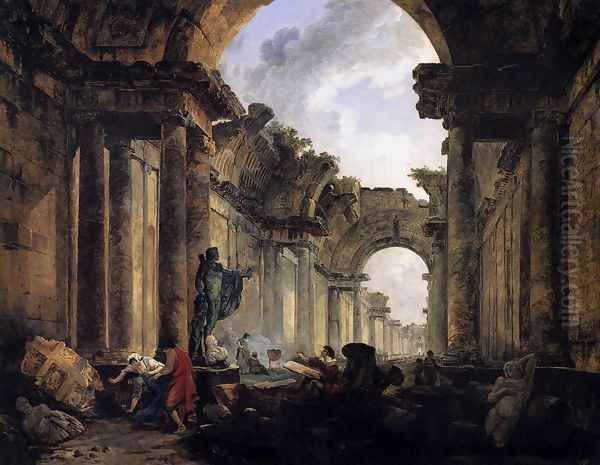
A pivotal moment arrived in 1754. Thanks to the patronage of his father's employer, now the Duc de Choiseul and appointed French ambassador to Rome, the young Robert was able to travel to Italy. This journey marked the beginning of an eleven-year residency that profoundly shaped his artistic vision. Rome, with its staggering accumulation of ancient ruins juxtaposed against vibrant contemporary life, provided an inexhaustible source of inspiration.
In Italy, Robert immersed himself in the artistic milieu. He studied the works of Italian masters, particularly the veduta painters (view painters). He was deeply influenced by the topographical precision and picturesque compositions of Giovanni Paolo Panini, who often depicted Roman landmarks and festivities. Equally significant was the impact of Giovanni Battista Piranesi, whose dramatic etchings of Roman antiquities, emphasizing their sublime grandeur and decay, resonated with Robert's own developing sensibilities. While Panini offered a model for clarity and composition, Piranesi perhaps fueled the more imaginative and melancholic aspects of Robert's art.
During his time in Rome, Robert formed a close friendship and working relationship with fellow French artist Jean-Honoré Fragonard. Together, they sketched outdoors, capturing the light and atmosphere of the Italian countryside and ancient sites. In 1760, they undertook a journey south to Naples, visiting Pompeii and Herculaneum, further enriching Robert's visual vocabulary of antiquity. This period saw the creation of numerous drawings and paintings depicting actual Roman views, such as the Interior of the Colosseum (1759) and studies related to the Arch of Santa Maria Maggiore (c. 1757/58), alongside his first forays into the capriccio genre. He also encountered the work of earlier masters like Claude Lorrain and Nicolas Poussin, whose idealized landscapes provided a classical foundation.
Return to Paris and Academic Acclaim
Robert returned to Paris in 1765, his portfolio filled with sketches and his artistic identity significantly matured. His Italian experiences had equipped him with a unique specialty – the depiction of ruins and picturesque landscapes – which quickly found favour with the Parisian public and collectors. His work stood out for its blend of observed reality and imaginative reconstruction.
His success was swift. In 1766, he was admitted to the prestigious Académie Royale de Peinture et de Sculpture (Royal Academy of Painting and Sculpture) as a painter of architectural subjects. His reception piece, likely a version of the View of the Port of Ripetta, Rome, showcased his ability to handle complex perspectives and lively detail. He became a regular and popular exhibitor at the biennial Paris Salons, the most important public art exhibitions of the era.
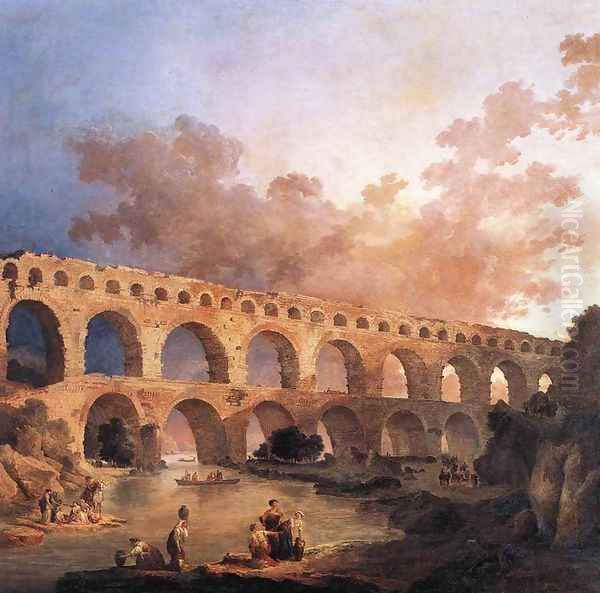
His works shown at the Salon of 1767 were particularly well-received, drawing praise from influential critics like Denis Diderot. Diderot, a key figure of the Enlightenment, admired the poetic quality and the "sublime" effect of Robert's ruins, though he sometimes tempered his praise with criticism that Robert occasionally prioritized pleasing aesthetics over deeper historical or philosophical meaning. Nonetheless, Robert's reputation soared, establishing him as a leading landscape painter alongside contemporaries like Joseph Vernet, known for his seascapes and harbour scenes.
Master of Ruins and Capricci
Hubert Robert's fame rests largely on his mastery of two intertwined genres: the depiction of actual ruins and the creation of architectural fantasies known as capricci. While he painted recognizable sites from Rome and France, he became particularly renowned for his imaginative compositions where elements from different places and times were artfully combined into entirely new, often melancholic, vistas.
A capriccio is essentially an architectural fantasy. Robert would take liberties with topography, juxtaposing famous monuments like the Pantheon or the Colosseum with imaginary structures, overgrown vegetation, and scenes of contemporary life. Washerwomen might spread laundry amidst the crumbling arches of an ancient temple, or artists might sketch within the decaying grandeur of a Roman bath. This blend of the monumental past with the ephemeral present created a unique poignancy, inviting contemplation on the passage of time, the vanity of human ambition, and the enduring power of nature.
His paintings often possess a distinct atmosphere – sometimes bathed in the golden light of Italy, other times imbued with a more northern, pre-Romantic sensibility. He excelled at rendering textures – crumbling stone, lush foliage, shimmering water – and used light and shadow effectively to create depth and drama. Works like Imaginary View of the Grande Galerie of the Louvre in Ruins (1796) exemplify this approach, presenting a familiar Parisian landmark transformed by time and decay into a scene of haunting beauty. Other works, like Architectural Caprice with the Roman Forum, showcase his skill in orchestrating complex spatial arrangements filled with recognizable yet rearranged classical elements.
Versatility Beyond the Canvas: Gardens and Decoration
Hubert Robert's artistic talents were not confined to easel painting. He was also highly sought after as a designer of gardens and decorative schemes. The late eighteenth century saw a shift in landscape gardening away from the formal French style, epitomized by André Le Nôtre's work at Versailles, towards the more naturalistic English landscape garden. Robert became a key proponent of this picturesque style in France.
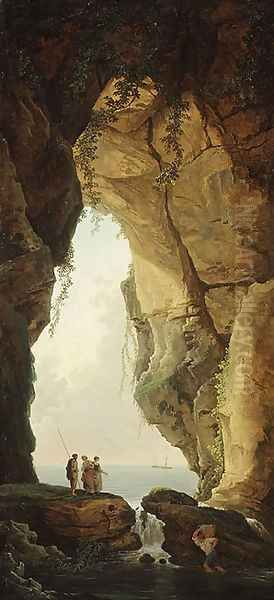
He held the official title of Dessinateur des Jardins du Roi (Designer of the King's Gardens) and was involved in projects for the French monarchy and aristocracy. He contributed designs for improvements at the gardens of Versailles and Fontainebleau. Perhaps his most famous landscape design project was for the Marquis de Laborde at the Château de Méréville, considered one of the finest examples of the picturesque garden in France. He also worked on the park at Ermenonville, famous for its association with the philosopher Jean-Jacques Rousseau.
Often, Robert's paintings themselves served as inspiration or direct models for garden features. His canvases depicting idyllic landscapes with follies, grottoes, and artificial ruins provided a visual blueprint for patrons seeking to create similar effects on their estates. He also undertook large-scale decorative painting projects, creating sets of panels designed to adorn the interiors of aristocratic homes, often featuring his signature landscapes and ruins. These commissions included work for royal patrons like Marie Antoinette at the Petit Trianon.
Navigating the French Revolution
The outbreak of the French Revolution in 1789 dramatically altered the artistic landscape and Robert's personal circumstances. As an artist who had enjoyed royal and aristocratic patronage, he inevitably fell under suspicion during the Reign of Terror. His connections to the nobility led to his arrest in October 1793.
Robert spent ten months imprisoned, first at Sainte-Pélagie and later at Saint-Lazare. Anecdotes suggest he narrowly escaped execution due to a case of mistaken identity, another prisoner with a similar name being sent to the guillotine in his place. Even during his confinement, Robert continued to draw and paint, capturing scenes of prison life on plates and scraps of paper, demonstrating remarkable resilience.
His fortunes changed with the fall of Robespierre in July 1794. Robert was released from prison. Remarkably, despite his past associations, he managed to navigate the shifting political tides. Even before his imprisonment, in 1793, he had been appointed as one of the first curators of the newly established Muséum Central des Arts in the Louvre Palace. This role involved planning the arrangement and display of the nationalized art collections. His involvement with the Louvre project likely provided him with a degree of protection and demonstrated his utility to the new regime.
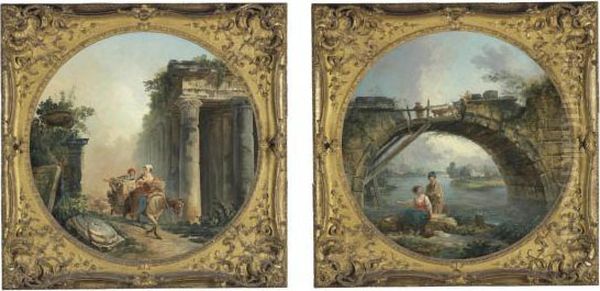
The Revolution inevitably impacted his art. Some works directly reflect the era's events, such as The Desecration of the Royal Tombs at Saint-Denis or the Demolition of the Church of the Collège des Cholets, documenting the destruction wrought by revolutionary fervor while perhaps subtly critiquing the loss of cultural heritage. His famous painting Imaginary View of the Grande Galerie of the Louvre in Ruins (1796), created after his release, can be interpreted not just as a reflection on time's passage but perhaps also as a commentary on the fragility of cultural institutions during periods of upheaval, contrasting sharply with the more politically charged works of contemporaries like Jacques-Louis David.
Later Years, Legacy, and Personal Life
Following his release from prison and the end of the Terror, Hubert Robert resumed his active career. He continued to paint prolifically and remained involved with the Louvre museum. In 1802, he was granted lifetime lodging within the Louvre palace itself, a testament to his esteemed position in the post-revolutionary art world.
His personal life seems to have been marked by both companionship and loss. In 1767, he married Anne-Gabrielle Soos, who was significantly younger than him. The couple had four children, but tragically, none survived infancy. Anne-Gabrielle herself lived until 1821, surviving her husband by thirteen years. The details of their later life together, particularly during the revolutionary turmoil, remain somewhat unclear, but the marriage endured through decades of change.
Hubert Robert died suddenly from a stroke in his Louvre apartment on April 15, 1808, at the age of 75. He left behind an immense body of work, estimated at around one thousand paintings and perhaps as many as ten thousand drawings. His artistic legacy was secured. He was admired for his technical facility, his poetic vision, and his unique ability to evoke the melancholy beauty of the past.
His influence extended into the nineteenth century. His picturesque landscapes and fascination with ruins resonated with the burgeoning Romantic movement across Europe. Artists exploring themes of history, nature, and the sublime, such as Caspar David Friedrich in Germany or J.M.W. Turner in England, shared some of Robert's sensibility, even if their styles differed significantly. In France, he remained a key figure in the development of landscape painting.
Hubert Robert in Major Collections
Today, Hubert Robert's works are held in major museums and collections around the world, attesting to his enduring appeal. The Musée du Louvre in Paris holds a significant collection, including iconic pieces like the Imaginary View of the Grande Galerie of the Louvre in Ruins and The Pont du Gard.
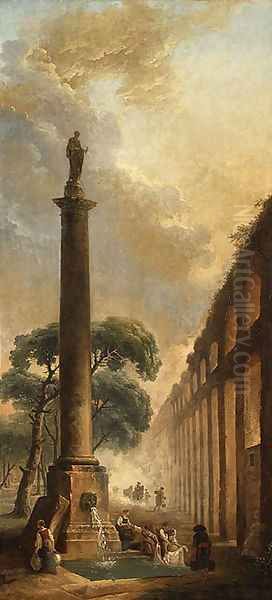
In the United States, the National Gallery of Art in Washington D.C. boasts an extensive collection of over one hundred works, encompassing paintings, drawings, and watercolours, providing a comprehensive overview of his career. The Metropolitan Museum of Art in New York also features important examples of his work, such as The Mouth of a Cave and various capricci.
Other notable collections include the Hermitage Museum in St. Petersburg (reflecting Russian aristocratic collecting tastes in the 18th century), the Musée Carnavalet (Museum of the History of Paris), the J. Paul Getty Museum in Los Angeles, and numerous regional museums in France, such as the Musée des Beaux-Arts in Valenciennes. This wide distribution highlights his international reputation both during his lifetime and subsequently.
Conclusion: An Enduring Vision
Hubert Robert occupies a unique and significant place in the history of art. He was more than just a painter of ruins; he was a visual poet who used the remnants of the past to explore timeless themes of memory, loss, and the relentless cycle of creation and decay. His work bridges the elegance of the Rococo with the burgeoning sensibilities of Neoclassicism and Romanticism.
His ability to blend topographical accuracy with imaginative fantasy, his technical skill in capturing light and atmosphere, and his versatility across painting, drawing, and design made him one of the most successful and influential artists of his generation. From the sun-drenched ruins of Rome to the revolutionary turmoil of Paris, Robert's art provides a captivating window onto the eighteenth century, filtered through a distinctly picturesque and melancholic lens. "Robert des ruines" created a world on canvas where past and present coexist, inviting viewers to contemplate the enduring dialogue between humanity, history, and the natural world. His vision continues to resonate, securing his legacy as a master interpreter of time's passage etched in stone and paint.